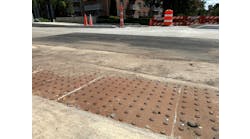Interstate highways around Montgomery, Ala., are about to be slammed with thousands (maybe tens of thousands) of extra trucks every month, but it isn’t because Montgomery is growing.
Instead, it is because Montgomery is on the shortest path between the Port of Mobile’s expanded container port (up from 50,000 to 800,000 TEUs a year) and mid-America.
In the past, highway planners in Alabama’s Department of Transportation (ALDOT) might not have seen that dramatic boost in truck traffic coming down the road. Like other states, it did not have an accurate system for forecasting how much freight traffic might grow on specific roads: Nationwide, most forecasts of the volume and growth of truck traffic have missed both marks by more than 50%.
The Integrated Freight Planning Framework (IFPF), a new freight forecasting model developed at the University of Alabama in Huntsville, is helping to fill those and other gaps in predicting freight load. It will help forecast where and when highway maintenance or expansion will be needed (including Montgomery). It can generate freight-flow patterns and volumes at both statewide and metropolitan statistical area scales.
“Traditional transportation planning often ignores freight in the planning process or adds it as an afterthought, perhaps as a percentage of a passenger car traffic forecast,” said Dr. Gregory Harris, P.E., director of the University of Alabama-Huntsville’s Office for Freight, Logistics and Transportation (OFLT). “We’re trying to figure out how to establish accurate freight transportation needs. We are studying infrastructure and freight and how they work together to support economic growth.”
While the framework’s first projects were for ALDOT and the Mobile Metropolitan Planning Organization, its creators are confident it can be used for any state or region of the U.S. (They also are doing preliminary work with data from the European Union.)
Accurate estimates of truck traffic are critical: While trucks make up between 8 and 25% of vehicles on most highways, one loaded truck does as much damage as 3,000 automobiles.
Trucks also eat up highway capacity. On level ground, an 18-wheeler takes up the space of one-and-a-half cars. On hills, that can triple. In that case, the 25% of traffic that is trucks on some busy highways might take up more than half of the capacity.
Obviously, missing a truck-traffic forecast on a busy highway by 50 to 100% might mean significantly underestimating what is needed for that highway’s maintenance and repair (or expansion).
The IFPF models integrate the freight component with passenger car models (which are reasonably accurate and reliable) to give planners a more meaningful picture of traffic growth and patterns.
Crunching the numbers
Harris and his University of Alabama-Huntsville team started this project with the idea of investigating the links between transportation infrastructure and economic growth.
“Freight transportation is vital to the growth and economic development of a state or region, but it became evident rather quickly that the data for freight analysis and the tools needed to include freight in the conversation where not available,” Harris said. “The main purpose behind this effort was to provide useful tools and data to transportation planners and decision makers.”
Traditional methods for predicting truck traffic used population and employment as proxies for estimating the volume of freight. While it might work for estimating passenger car traffic, that system does not take into account such things as improved productivity in many industries. Using employment numbers to forecast freight traffic means that if local companies use fewer employees to achieve higher productivity (more goods to move), the model might forecast declining rather than growing truck traffic.
Passive traffic-counting equipment tallies axle hits, but they cannot tell how many belong to motorcycles, cars, short trucks or long trucks.
IFPF supplements the population and employment numbers with two additional data points: the value of shipments and personal (household) income.
“As the affluence [personal income] of an area increases, the population demands more products, increasing the need for freight systems to deliver consumer goods,” Harris said. “We also looked at retail employment, since retail is a freight attractor. If you have an affluent community, you’re looking at an area that is going to generate a lot of freight traffic as goods are delivered that final mile to the consumer.
“The value of shipments provides more reliable data for estimating how much freight traffic is being generated by industries within a given region.”
One of the team’s goals was to learn “freight-generation principles” (such as the number of incoming and outgoing shipments produced by a specific volume of production) for many industries. With that information in hand, it might be possible to apply those principles to do an “industry sector analysis” anywhere each industry is found to estimate how much freight a region, state or MSAs composite industry is putting into local, regional and national transportation systems.
Applied to Alabama
The team’s first project was to develop a freight-planning model for ALDOT. Although the disaggregated national database includes information from each of the state’s 67 counties, the Univeristy of Alabama-Huntsville team found that many counties did not have significant levels of freight activity.
Instead, it used data-clustering techniques to divide Alabama into 27 logical freight zones, then studied population, businesses and specific industries in each zone to get a clear picture of how many trucks are moving in and out of each zone. The model also gives planners a better idea of zones where traffic might grow fastest.
“Now that we know what industries are in Alabama and their locations, we can do growth projections by industry type over the next several years,” Harris said. “With the right growth data we can query the models and ask, Where are the congestion issues we need to deal with to promote economic development?”
In the Alabama analysis, they found that increased truck traffic on I-65 between Montgomery and Birmingham will have a major impact in coming years: Assuming nothing is done, the posted speed limit might be 70 mph but during daily peak travel times the actual speed of travel might be only half of that.
A combination of national, regional, statewide and local data give the University of Alabama-Huntsville team’s forecasts unique flexibility.
“We have the ability to focus on how our actions might change traffic volume on one specific stretch of road,” said Dr. Michael Anderson, P.E., an associate professor of civil engineering and a member of the OFLT team. “We can calculate the number of vehicle-miles traveled if one stretch of highway is built or improved versus spending that money on a different stretch of highway.
“That can help set project priorities. We can begin to answer the question, Which of these options is best? That is especially important if a state has 15 priority projects on the books but only has funding for three.”
Anderson also developed a technique using national economic and industry-specific data to estimate the volume of “pass-through” truck traffic that neither starts nor stops in a study area or state.
“One of the surprising things we found was the volume of pass-through traffic,” he said. “Now we can add that to our forecasts as a base flow of traffic that is just passing through. We are finding the traffic flows that are going to have an impact on Alabama that we have no control over. Until now there was no verifiable way to assess pass-through traffic volume.”
Alabama and Mississippi are feeling the effects from some of that increased pass-through traffic now and will see more when the last pieces of I-22 are finished near Birmingham. While I-22 will give passenger and freight traffic a more direct connection between Birmingham and Memphis, the impact will be felt on Birmingham’s downtown interstates as thousands of trucks traveling between Florida and the Midwest are diverted off of I-75 and I-40. (Trip planning software used by Google and Yahoo already report I-22 as part of the shortest, quickest route between Memphis and Florida’s ports.)
The Mobile model
With a major expansion under way at the Port of Mobile’s container-handling facility, Kevin Harrison was concerned about the effect an extra 372,000 container trucks a year will have on the Mobile-area’s highway system.
“That’s a pretty major port expansion,” said Harrison, the director of transportation planning for the South Alabama Regional Planning Commission. “I looked at our model and said, ‘We really need to do something with trucks here.’ We have I-10 going through the middle of town and I-65 terminating at I-10. Both already have pretty major bottlenecks.
“Then I saw what the Univerity of Alabama-Huntsville team had produced for the state. [Harris] was saying he would like to have a demonstration project to see what their freight framework would do, so we hired them to help us develop a freight plan.”
What the Univeristy of Alabama-Huntsville team did for Mobile was to develop techniques for taking two pieces of different types of data to determine how much freight is moving in an area. One of the innovative things Mobile has done is to collect data on companies in the metro area.
“We have someone on our staff who goes out and interviews people who use freight in their production,” Harrison said. “Instead of asking the trucking companies and rail lines, we’re asking the users of those trucking companies and rail lines. We’re one of the first cities our size [population about 200,000] to have something like this.”
“You can’t take a national economic forecast and assume that the same thing is going to happen in Alabama or Mobile,” Harris said. “By doing local surveys, they find out a lot of important information that they can use. They find out about planned expansions or cutbacks. With that data in hand you can put together some tailored forecasts.”
Some of the findings were surprising. Truck traffic did not always take the shortest or quickest route, opting instead for routes that were more “convenient.” Sometimes loads bound for distant markets first went across town, where cabs were exchanged—local for long distance.
Harrison is using the University of Alabama-Huntsville freight model results as part of the Mobile Metropolitan Planning Organization’s five-year, long-range highway planning process.
“We’ll have various scenarios for the highway model’s projects,” he said. “When we’re done I fully expect to have a forecast model for all modes of freight. The model will show us which roads are at or over capacity, and we’ll have kind of the same thing for freight as well.
“If something happens in Huntsville or on the Tenn-Tom Waterway, our model should be able to react to that.”
The enlarged container port facility is not the only factor driving freight in Mobile: A massive ThyssenKrupp steel plant is being built there (“One of the walls of this thing is a mile long.”) and Mobile is on the short list as a possible site for a plant to build refueling tanker aircraft for the U.S. Air Force.
“We don’t want our infrastructure to impede our growth,” Harrison said, “so we’re at least trying to plan for it.”
Pulling product, pushing limits
The IFPF and the improved information that it provides about freight patterns and growth come at what could be a critical time, when several factors are coming together to create major challenges for transportation planners.
“Travel is increasing at a rate that quickly consumes capacity,” Harris said. “U.S. infrastructure is reaching or exceeding its expected life timelines and needs replacement or renovation. But most of the funds received by state departments of transportation go to maintaining the infrastructure in its current condition, with little left over for increasing capacity or making functional improvements.
“At the same time, the global economy is putting freight into the supply chain for longer periods of time. A generation ago you might have factories that were 300 miles and a one-day delivery from its customers. Now you have factories in Asia and products that might take a month and a half to get to the consumer. But wherever it is produced, it’s going to be on a truck at some part of the process.”
The IFPF was developed to give decision makers information that they can use to make the best decisions to benefit the greatest number of citizens.
“Without improvements, it is possible that there will be a significant increase in the number of times products cannot reach the marketplace or customer when they are needed,” said Harris. “Our hope is that the information created by IFPF will identify potential transportation problems before congestion limits economic growth.
“We are continuing to develop the IFPF to provide information to ALDOT’s Maintenance Bureau to help determine the life expectancy of roads,” Harris said, “based on a better understanding of how many trucks are using those roads and the damage they might do to pavement or a bridge because of the weight and speed of the vehicles.
“The models are designed to give highway planners information that can be used to make decisions on how much to maintain, how much to expand and how much revenue you need to support that.”


